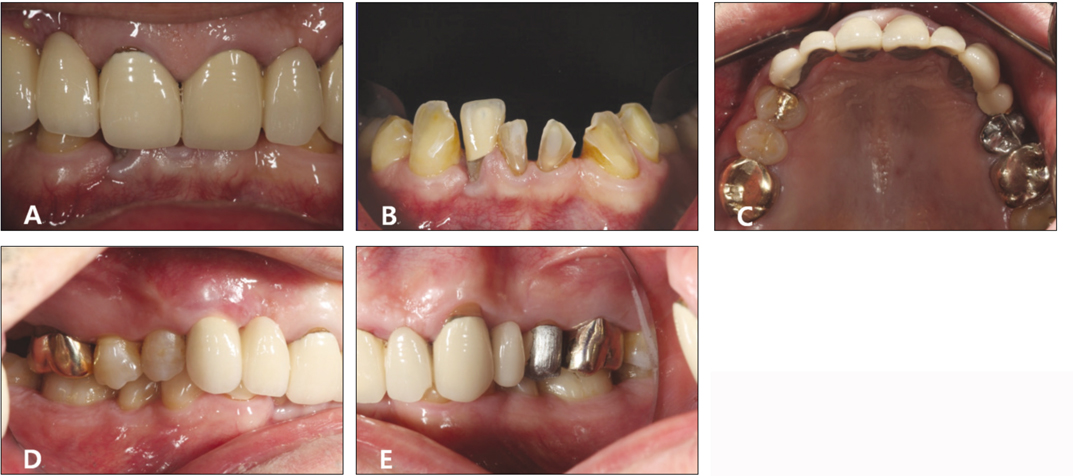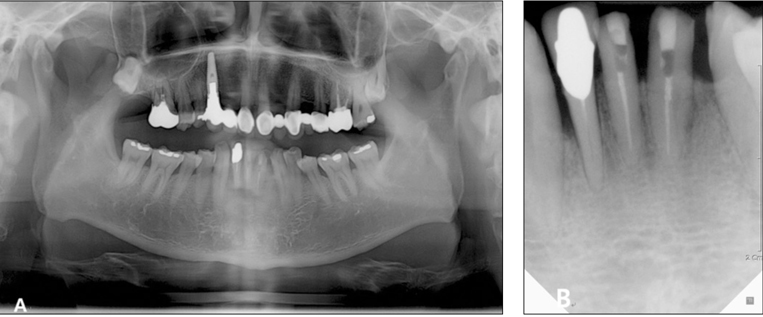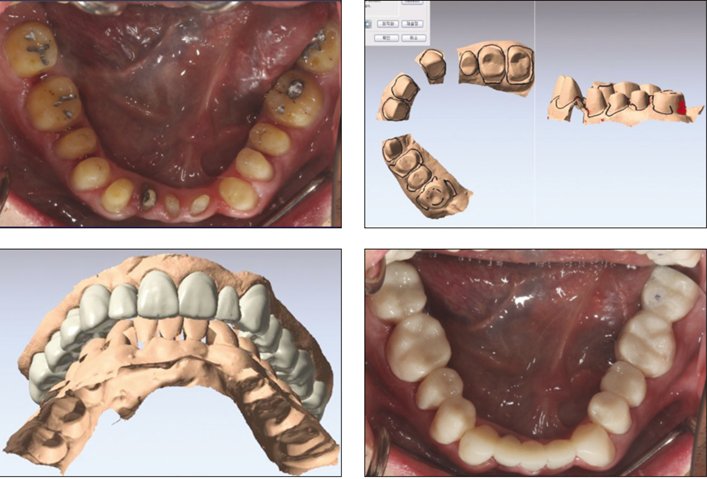J Korean Acad Prosthodont.
2012 Jul;50(3):198-203. 10.4047/jkap.2012.50.3.198.
Full mouth rehabilitation of the patient with worn dentition using full-contour monolithic zirconia prostheses at an increased vertical dimension of occlusion: a case report
- Affiliations
-
- 1Department of Prosthodontics, Graduate School, Yonsei University, Seoul, Korea. jfshim@yuhs.ac
- KMID: 2000209
- DOI: http://doi.org/10.4047/jkap.2012.50.3.198
Abstract
- Excessive occlusal wear results in unacceptable damage to the occluding surfaces, and can cause pulpal injury, occlusal disharmony, impaired function, and aesthetic deformity. Patients with severely worn dentition need to be classified as several categories relative to the vertical dimension of occlusion (VDO) and the interocclusal distance for the prosthetic space. When treating patients classified as those who have excessive wear without loss of occlusal vertical dimension but with limited space, we could consider treating them at an increased vertical dimension of occlusion. Treatments at an increased vertical dimension of occlusion may provide stability, given that the amount of its increase was minimal, and a perfected occlusion was achieved after enough stabilization period. A 50-year-old male visited the department of Prosthodontics in Yonsei University Dental Hospital with the chief complaint of worn teeth on lower anterior area. Reconstruction at an increased vertical dimension of occlusion was planned. After the compatibility of the new vertical dimension of occlusion had been confirmed under interim fixed restorations, definitive fixed restorations composed of full-contour monolithic zirconia prostheses were placed. This case presents that a satisfactory clinical result was achieved by restoring the worn dentition at an increased vertical dimension of occlusion with an improvement in esthetics and function.
MeSH Terms
Figure
Reference
-
1. Dawson PE. Functional occlusion : from TMJ to smile design. 2007. St. Louis; Mo: Mosby;430–452.2. Turner KA, Missirlian DM. Restoration of the extremely worn dentition. J Prosthet Dent. 1984. 52:467–474.
Article3. Murphy T. Compensatory mechanisms in facial height adjustment to functional tooth attrition. Aust Dent J. 1959. 4:312–323.
Article4. Murphy TR. The progressive reduction of tooth cusps as it occurs in natural attrition. Dent Pract Dent Rec. 1968. 19:8–14.5. Hemmings KW, Howlett JA, Woodley NJ, Griffiths BM. Partial dentures for patients with advanced tooth wear. Dent Update. 1995. 22:52–59.6. Dahl BL. The face height in adult dentate humans. A discussion of physiological and prosthodontic principles illustrated through a case report. J Oral Rehabil. 1995. 22:565–569.
Article7. Dahl BL, Krogstad O. Long-term observations of an increased occlusal face height obtained by a combined orthodontic/prosthetic approach. J Oral Rehabil. 1985. 12:173–176.
Article8. Sato S, Hotta TH, Pedrazzi V. Removable occlusal overlay splint in the management of tooth wear: a clinical report. J Prosthet Dent. 2000. 83:392–395.
Article9. Bloom DR, Padayachy JN. Increasing occlusal vertical dimension-why, when and how. Br Dent J. 2006. 200:251–256.
Article10. Ramfjord SP, Ash MM. Reflections on the Michigan occlusal splint. J Oral Rehabil. 1994. 21:491–500.
Article11. Hoyle DE. Fabrication of a customized anterior guide table. J Prosthet Dent. 1982. 48:490–491.
Article12. Smith BH. Changes in occlusal face height with removable partial prostheses. J Prosthet Dent. 1975. 34:278–285.
Article13. Griffiths MJ. Telemetry and the study of vertical jaw relations. J Dent. 1975. 3:261–266.
Article14. Rivera-Morales WC, Mohl ND. Relationship of occlusal vertical dimension to the health of the masticatory system. J Prosthet Dent. 1991. 65:547–553.
Article15. Palmer DS, Barco MT, Pelleu GB Jr, McKinney JE. Wear of human enamel against a commercial castable ceramic restorative material. J Prosthet Dent. 1991. 65:192–195.
Article16. Oh WS, Delong R, Anusavice KJ. Factors affecting enamel and ceramic wear: a literature review. J Prosthet Dent. 2002. 87:451–459.
Article17. Albashaireh ZS, Ghazal M, Kern M. Two-body wear of different ceramic materials opposed to zirconia ceramic. J Prosthet Dent. 2010. 104:105–113.
Article
- Full Text Links
- Actions
-
Cited
- CITED
-
- Close
- Share
- Similar articles
-
- Full mouth rehabilitation using zirconia crown in severe worn dentition: a case report
- Full mouth rehabilitation of the patient with severely worn dentition using monolithic zirconia prosthesis: A clinical report
- Full mouth rehabilitation with vertical dimension increase in patient with severly worn dentition
- Full mouth rehabilitation of a patient with worn dentition and loss of posterior support by vertical dimension reestablishment: a clinical report
- Full mouth rehabilitation of patient with excessively worn dentition from multiple factors: a case report





